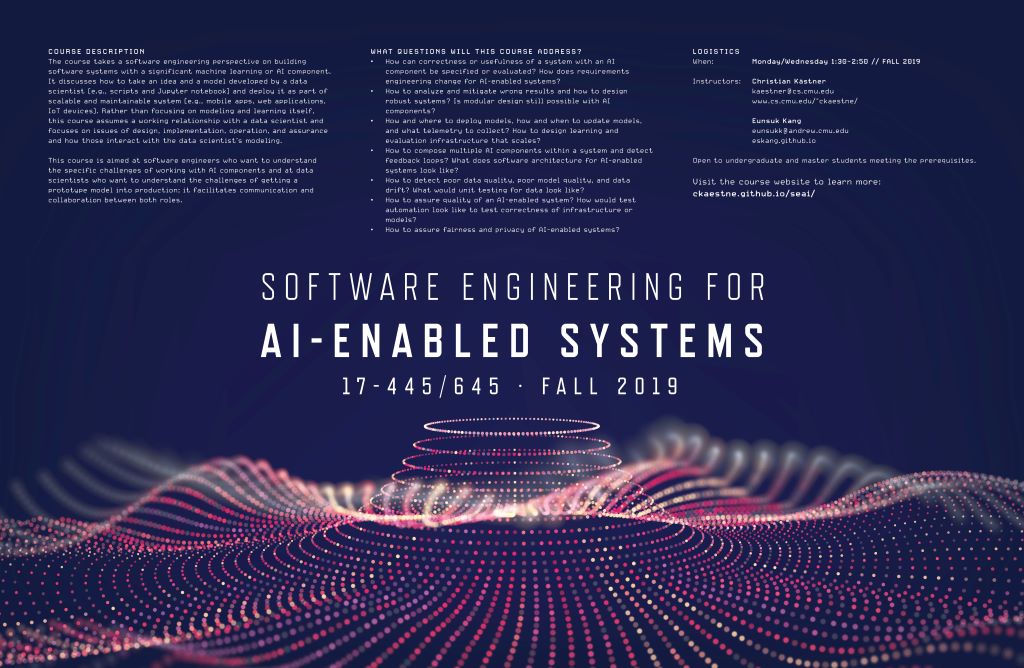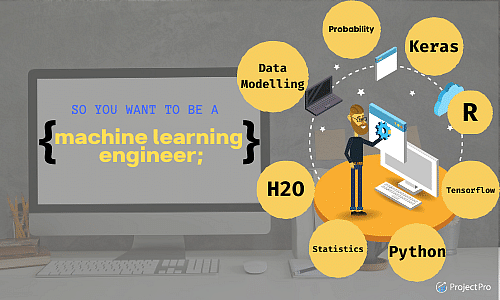All Categories
Featured
Table of Contents
- – 7 Easy Facts About Best Online Machine Learnin...
- – The Best Strategy To Use For Machine Learning ...
- – The smart Trick of Software Engineering For A...
- – Examine This Report about Llms And Machine Le...
- – Pursuing A Passion For Machine Learning Fund...
- – Getting The Ai And Machine Learning Courses ...
- – Some Known Details About How To Become A Mac...
Some individuals assume that that's disloyalty. If somebody else did it, I'm going to use what that person did. I'm forcing myself to think through the feasible remedies.
Dig a little deeper in the mathematics at the beginning, so I can build that structure. Santiago: Lastly, lesson number 7. This is a quote. It states "You need to understand every detail of an algorithm if you wish to use it." And after that I claim, "I believe this is bullshit suggestions." I do not believe that you need to recognize the nuts and screws of every formula before you utilize it.
I have actually been utilizing neural networks for the longest time. I do have a feeling of just how the gradient descent works. I can not discuss it to you right now. I would certainly need to go and examine back to actually obtain a much better intuition. That doesn't imply that I can not address points using semantic networks, right? (29:05) Santiago: Trying to require people to assume "Well, you're not mosting likely to be successful unless you can clarify each and every single information of just how this works." It goes back to our arranging instance I think that's just bullshit suggestions.
As an engineer, I have actually worked with many, numerous systems and I've utilized numerous, lots of things that I do not recognize the nuts and bolts of how it works, although I recognize the influence that they have. That's the last lesson on that particular thread. Alexey: The amusing thing is when I consider all these collections like Scikit-Learn the algorithms they use inside to implement, for instance, logistic regression or another thing, are not the like the algorithms we examine in artificial intelligence classes.
7 Easy Facts About Best Online Machine Learning Courses And Programs Described
Also if we attempted to learn to obtain all these essentials of maker discovering, at the end, the algorithms that these collections utilize are different. Santiago: Yeah, definitely. I assume we need a lot extra materialism in the industry.

Incidentally, there are two various paths. I normally talk to those that want to operate in the industry that want to have their influence there. There is a path for scientists and that is entirely various. I do not risk to discuss that since I do not recognize.
Right there outside, in the industry, pragmatism goes a lengthy method for sure. (32:13) Alexey: We had a remark that stated "Really feels more like motivational speech than chatting concerning transitioning." So possibly we must switch over. (32:40) Santiago: There you go, yeah. (32:48) Alexey: It is a great inspirational speech.
The Best Strategy To Use For Machine Learning Engineer Full Course - Restackio
One of the things I intended to ask you. I am taking a note to speak about coming to be much better at coding. Initially, let's cover a pair of things. (32:50) Alexey: Let's begin with core devices and structures that you need to learn to really change. Let's state I am a software designer.
I recognize Java. I understand SQL. I understand exactly how to utilize Git. I understand Bash. Maybe I recognize Docker. All these things. And I find out about device understanding, it appears like a great point. What are the core devices and frameworks? Yes, I enjoyed this video clip and I obtain convinced that I do not require to get deep right into mathematics.
Santiago: Yeah, absolutely. I believe, number one, you need to start discovering a little bit of Python. Given that you already know Java, I do not think it's going to be a big shift for you.
Not since Python is the very same as Java, but in a week, you're gon na get a great deal of the differences there. You're gon na have the ability to make some progression. That's primary. (33:47) Santiago: Then you get particular core devices that are going to be used throughout your whole occupation.
The smart Trick of Software Engineering For Ai-enabled Systems (Se4ai) That Nobody is Discussing
That's a library on Pandas for data manipulation. And Matplotlib and Seaborn and Plotly. Those three, or among those 3, for charting and presenting graphics. After that you obtain SciKit Learn for the collection of artificial intelligence algorithms. Those are devices that you're mosting likely to have to be making use of. I do not advise simply going and discovering them out of the blue.
Take one of those programs that are going to start presenting you to some troubles and to some core ideas of device learning. I do not remember the name, but if you go to Kaggle, they have tutorials there for free.
What's excellent concerning it is that the only demand for you is to recognize Python. They're going to present a trouble and inform you exactly how to make use of choice trees to fix that details issue. I believe that process is very effective, since you go from no device finding out background, to understanding what the problem is and why you can not address it with what you recognize right now, which is straight software engineering practices.
Examine This Report about Llms And Machine Learning For Software Engineers
On the other hand, ML engineers concentrate on building and deploying equipment discovering models. They concentrate on training designs with data to make forecasts or automate tasks. While there is overlap, AI designers deal with more varied AI applications, while ML designers have a narrower concentrate on equipment learning formulas and their functional implementation.

Equipment knowing designers focus on establishing and releasing device knowing designs into manufacturing systems. On the various other hand, information researchers have a broader duty that consists of information collection, cleaning, expedition, and building designs.
As organizations significantly adopt AI and device learning technologies, the demand for skilled experts expands. Machine knowing designers function on innovative tasks, add to innovation, and have competitive wages.
ML is essentially different from typical software advancement as it concentrates on teaching computer systems to pick up from information, instead of programs explicit guidelines that are carried out methodically. Unpredictability of outcomes: You are possibly made use of to creating code with predictable results, whether your function runs as soon as or a thousand times. In ML, however, the outcomes are less certain.
Pre-training and fine-tuning: How these models are educated on substantial datasets and after that fine-tuned for particular jobs. Applications of LLMs: Such as text generation, view evaluation and details search and access. Documents like "Focus is All You Need" by Vaswani et al., which presented transformers. On the internet tutorials and courses concentrating on NLP and transformers, such as the Hugging Face course on transformers.
Pursuing A Passion For Machine Learning Fundamentals Explained
The capacity to take care of codebases, merge changes, and fix conflicts is equally as essential in ML growth as it remains in standard software projects. The abilities created in debugging and testing software applications are very transferable. While the context may alter from debugging application reasoning to recognizing problems in data handling or version training the underlying principles of systematic examination, theory testing, and iterative improvement coincide.
Machine learning, at its core, is greatly dependent on statistics and chance theory. These are critical for recognizing how formulas pick up from information, make forecasts, and evaluate their efficiency. You need to take into consideration becoming comfy with ideas like statistical value, distributions, hypothesis screening, and Bayesian reasoning in order to style and translate models properly.
For those thinking about LLMs, an extensive understanding of deep discovering architectures is useful. This includes not only the mechanics of neural networks yet also the style of certain versions for different usage cases, like CNNs (Convolutional Neural Networks) for image handling and RNNs (Recurring Neural Networks) and transformers for consecutive data and all-natural language processing.
You should know these problems and learn methods for identifying, minimizing, and communicating about bias in ML designs. This consists of the prospective influence of automated decisions and the moral effects. Several models, specifically LLMs, call for considerable computational resources that are usually provided by cloud platforms like AWS, Google Cloud, and Azure.
Building these abilities will certainly not just assist in an effective transition into ML but likewise make sure that programmers can add effectively and responsibly to the development of this dynamic area. Theory is essential, but nothing defeats hands-on experience. Start servicing jobs that allow you to apply what you have actually found out in a practical context.
Develop your projects: Start with easy applications, such as a chatbot or a text summarization tool, and progressively enhance complexity. The area of ML and LLMs is swiftly advancing, with brand-new innovations and technologies arising on a regular basis.
Getting The Ai And Machine Learning Courses To Work
Contribute to open-source jobs or create blog articles about your learning journey and jobs. As you gain experience, begin looking for possibilities to integrate ML and LLMs into your work, or seek brand-new functions focused on these innovations.
Prospective use situations in interactive software application, such as recommendation systems and automated decision-making. Comprehending uncertainty, basic statistical measures, and chance circulations. Vectors, matrices, and their role in ML formulas. Mistake reduction strategies and gradient descent discussed simply. Terms like model, dataset, functions, tags, training, inference, and recognition. Information collection, preprocessing techniques, design training, assessment procedures, and release factors to consider.
Decision Trees and Random Forests: User-friendly and interpretable versions. Matching issue kinds with ideal designs. Feedforward Networks, Convolutional Neural Networks (CNNs), Persistent Neural Networks (RNNs).
Constant Integration/Continuous Deployment (CI/CD) for ML workflows. Model tracking, versioning, and efficiency tracking. Finding and resolving modifications in model performance over time.
Some Known Details About How To Become A Machine Learning Engineer - Uc Riverside

Course OverviewMachine knowing is the future for the next generation of software specialists. This training course acts as an overview to device knowing for software designers. You'll be introduced to three of the most pertinent parts of the AI/ML self-control; monitored understanding, neural networks, and deep learning. You'll understand the distinctions between standard programming and machine discovering by hands-on advancement in monitored understanding prior to developing out complex dispersed applications with neural networks.
This training course works as an overview to maker lear ... Program More.
Table of Contents
- – 7 Easy Facts About Best Online Machine Learnin...
- – The Best Strategy To Use For Machine Learning ...
- – The smart Trick of Software Engineering For A...
- – Examine This Report about Llms And Machine Le...
- – Pursuing A Passion For Machine Learning Fund...
- – Getting The Ai And Machine Learning Courses ...
- – Some Known Details About How To Become A Mac...
Latest Posts
The Best Free Courses To Learn System Design For Tech Interviews
Where To Find Free Faang Interview Preparation Resources
How To Use Youtube For Free Software Engineering Interview Prep
More
Latest Posts
The Best Free Courses To Learn System Design For Tech Interviews
Where To Find Free Faang Interview Preparation Resources
How To Use Youtube For Free Software Engineering Interview Prep